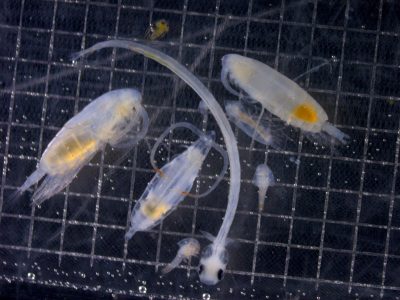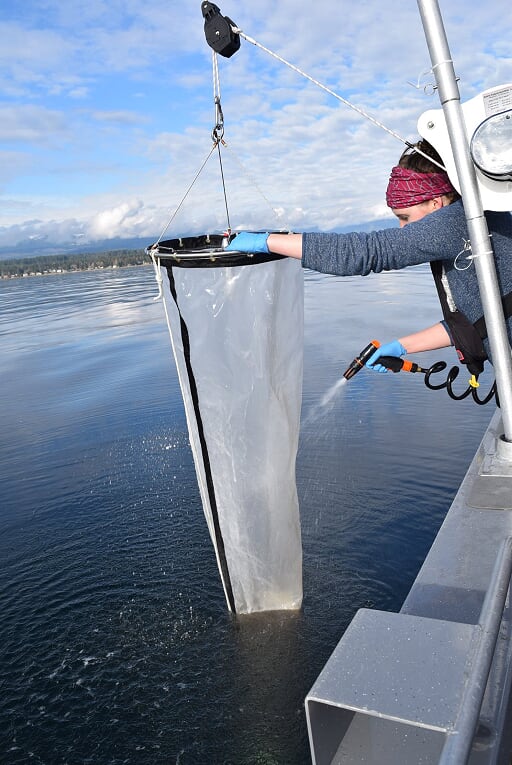British Columbia has one of the most complicated coastlines on earth: a maze of islands, channels, and fjords track the inside passage to Alaska, periodically ripped by tidal rapids that stir up cold water from the deep. New research from UBC’s Institute for the Oceans and Fisheries (IOF)’s Pelagic Ecosystem Lab shows that zooplankton communities are profoundly shaped by these dynamic conditions, creating a mosaic of foraging conditions for the juvenile salmon that depend on them for sustenance.
 Zooplankton is a catch-all term for an incredibly diverse group of organisms that are positioned near the bottom of the food chain in marine ecosystems. They graze on much smaller phytoplankton, producing energy from these tiny plants accessible to the rest of the ecosystem. Most marine animals consume zooplankton during at least some stage of their life cycle. Pacific Salmon are particularly dependent on them, with zooplankton being their primary food source as juveniles, extending into adulthood for most species. A good supply of zooplankton is essential for juveniles to grow quickly, get big enough to escape predators, and improve condition enough to survive their first winter at sea. Changes in the supply of coastal zooplankton is therefore critical to their survival.
Zooplankton is a catch-all term for an incredibly diverse group of organisms that are positioned near the bottom of the food chain in marine ecosystems. They graze on much smaller phytoplankton, producing energy from these tiny plants accessible to the rest of the ecosystem. Most marine animals consume zooplankton during at least some stage of their life cycle. Pacific Salmon are particularly dependent on them, with zooplankton being their primary food source as juveniles, extending into adulthood for most species. A good supply of zooplankton is essential for juveniles to grow quickly, get big enough to escape predators, and improve condition enough to survive their first winter at sea. Changes in the supply of coastal zooplankton is therefore critical to their survival.
A lot of research has focused on declines in zooplankton supply due to climate change as a cause of salmon declines. While important, little attention has been paid to how this supply might vary along the salmon migration route. However, new research by IOF researchers in partnership with the Hakai Institute shows that juvenile salmon can experience both feast and famine in the BC’s coastal waters. In narrow passageways like the Discovery Islands and Johnstone Strait, the tidal currents run strong and the resulting deep mixing regularly transports phytoplankton away from the surface into the dark depths where they are not able to photosynthesize. This leads to a phytoplankton desert in what is normally a very productive coastal ocean.
“Scarce phytoplankton is bad news for zooplankton, and so is being swept through narrows channels filled with benthic predators like anemones and pelagic consumers like fish,” said Dr. Evgeny Pakhomov, co-Principal Investigator of the study, Director of the Institute for the Oceans and Fisheries and professor in IOF and the UBC Department of Earth, Oceans and Atmospheric Sciences.
 The study found that the supply of nutritious zooplankton is greatly reduced in both number and size in these tidal passages. “The high prevalence of small zooplankton species in the tidally mixed regions indicated that large (i.e., better quality food for consumers) zooplankton aren’t being retained in the area, which is bad news for the juvenile salmon that have to spend at least 150 km swimming through these conditions” says Natalie Mahara, the study’s lead author and a recent IOF Master’s graduate. “We found a much higher number of large zooplankton in the northern Strait of Georgia and Queen Charlotte Strait, where surface waters are more stable and have higher phytoplankton production.”
The study found that the supply of nutritious zooplankton is greatly reduced in both number and size in these tidal passages. “The high prevalence of small zooplankton species in the tidally mixed regions indicated that large (i.e., better quality food for consumers) zooplankton aren’t being retained in the area, which is bad news for the juvenile salmon that have to spend at least 150 km swimming through these conditions” says Natalie Mahara, the study’s lead author and a recent IOF Master’s graduate. “We found a much higher number of large zooplankton in the northern Strait of Georgia and Queen Charlotte Strait, where surface waters are more stable and have higher phytoplankton production.”
“When we sampled juvenile sockeye salmon migrating through Johnstone Strait and Discovery Islands we found that there were a lot of empty stomachs. The juvenile fish were struggling to find enough food in these tidally mixed regions,” says Dr. Brian Hunt, Principal Investigator of the study and assistant professor at the Institute for the Oceans and Fisheries. “Based on tagging studies it is estimated that it takes about 10-12 days to migrate through the area. This is a long time to be go under-fed and makes it all the more important that they are able to feast before and after the journey.”
“One of our big concerns now is that warming oceans are decreasing the productivity of the normally productive waters on either side of Johnstone Strait and Discovery Islands. More famine and less feast is a major concern for the early marine survival of juvenile salmon,” Hunt concluded.
Mahara N, Pakhomov EA, Dosser HV, Hunt BPV (2021) How zooplankton communities are shaped in a complex and dynamic coastal system with strong tidal influence. Estuarine, Coastal and Shelf Science 249:107103
Tags: Brian Hunt, British Columbia, Evgeny Pakhomov, food webs, Hakai Institute, Pacific, plankton, salmon